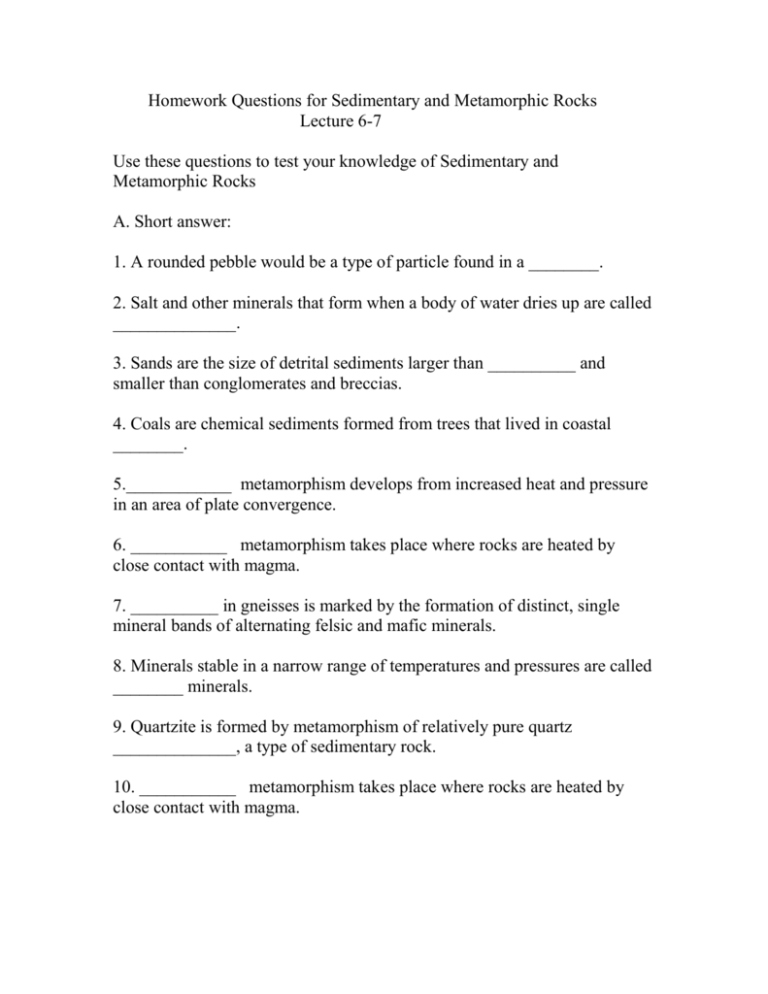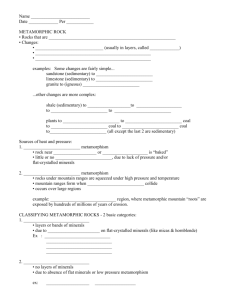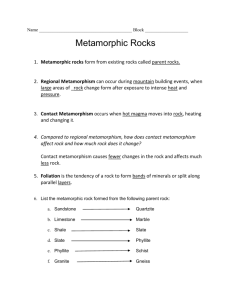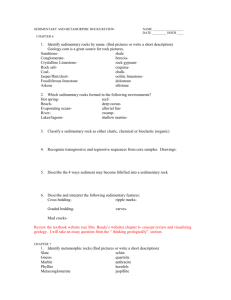Homework Questions for Sedimentary and Metamorphic Rocks
advertisement

Homework Questions for Sedimentary and Metamorphic Rocks Lecture 6-7 Use these questions to test your knowledge of Sedimentary and Metamorphic Rocks A. Short answer: 1. A rounded pebble would be a type of particle found in a ________. 2. Salt and other minerals that form when a body of water dries up are called ______________. 3. Sands are the size of detrital sediments larger than __________ and smaller than conglomerates and breccias. 4. Coals are chemical sediments formed from trees that lived in coastal ________. 5.____________ metamorphism develops from increased heat and pressure in an area of plate convergence. 6. ___________ metamorphism takes place where rocks are heated by close contact with magma. 7. __________ in gneisses is marked by the formation of distinct, single mineral bands of alternating felsic and mafic minerals. 8. Minerals stable in a narrow range of temperatures and pressures are called ________ minerals. 9. Quartzite is formed by metamorphism of relatively pure quartz ______________, a type of sedimentary rock. 10. ___________ metamorphism takes place where rocks are heated by close contact with magma. B. Match the terms 1. Evaporite minerals____ a. partially melted 2. Cementation ______ b. stable in narrow range T,P 3. Rounded particles > 2 mm c. mud 5. Still water detrital sediment ____ d. dynamothermal metamorphism 4. New England____ e. conglomerate 5. Banded metamorphic rock ____ f. gypsum and salt 6. Index mineral _____ g. glue grains together 7. Migmatite _____ h. gneiss C. True or False? 1. Mudcracks are useful for "right-side-up" determinations. True or False? 2. The most abundant types of sedimentary rock are conglomerates. True or False? 3. The degree to which sediment particles become rounded depends on their hardness, how far they are transported, and the energy of their collisions with other particles. True or False? 4. Deep lagoons are more effective in rounding sediment particles than swiftly flowing rivers. True or False? 5. Detrital sedimentary rocks are classified on the basis of their particle sizes. True or False? 6. Conglomerates form in high energy (fast water) environments, such as under breaking waves at the beach. True or False? 7. Mudstones form in very low energy (slow water) environments, such as in very deep water. True or False? 8. In metamorphism, heat melts the minerals. True or False? 9. Foliation refers to a consistent orientation of the mineral grains perpendicular to the direction of greatest pressure. True or False? 10.Water facilitates metamorphic reactions by allowing movement of atoms and ions. True or False? 11.The ultimate composition of a metamorphic rock is determined by the parent rock. True or False? 12.The metamorphism that results entirely from the heat of hot circulating fluids is called contact metamorphism. True or False? D. Multiple choice: 1) The main difference between a breccia and a conglomerate is: (a) particle size. (b) particle shape. (c) color. (d) mineral composition. 2) Ripple marks in sediments that were transported by water (in cross-section they appear as "cross-beds"), can tell us: (a) the direction of flow. (b) the current velocity (c) whether tides were important there. (d) All of the above 3) Of the following, the most likely environment of deposition for mudstone is: (a) in the surf zone. (b) in the rapids of a steep mountain stream. (c) below a waterfall. (d) the bottom of a quiet lagoon 4) Which of the following sedimentary structures would indicate deposition had occurred in shallow water with cycles of drought? (a) Graded bedding. (b) Ripple marks. (c) Mudcracks. (d) Cross-bedding. 5) Which series shows the progression of a mudrock to metamorphic rock from original deposition to the highest grade of metamorphism? a) Mud gneiss schist phyllite slate shale. b) Mud slate schist phyllite shale gneiss. c) Mud shale slate phyllite schist gneiss d) Mud schist phyllite gneiss slate shale 6) A rock that has partially melted and is thus part igneous and part metamorphic is a: (a) phyllite. (b) gneiss. (c) migmatite. (d) schist. 7) The rock that results from the metamorphism of limestone is: (a) hornfels. (b) quartzite. (c) gneiss. (d) marble. 8) Metamorphism of quartz sandstone produces: (a) hornfels. (b) quartzite. (c) gneiss. (d) marble. 9) Which one of the following rock types would allow analysis of metamorphic index minerals for pressure and temperature of formation? (a) Schist. (b) Limestone. (c) Quartzite. (d) Granite. 10) Serpentine-rich metamorphic rocks beneath the mid-ocean ridge show evidence of: (a) hydrothermal metamorphism. (b) directed pressure similar to that of fault-zone metamorphism. (c) lithostatic pressure similar to that of burial metamorphism. (d) regional metamorphism along the entire length of the mid-ocean ridge. E . No part E for these topics, sedimentary and metamorphic rocks. F. Calculations. 1. Null and Alternate Hypotheses. Continue reading Lecture 13 up to slide 31. Then complete the following: Since we rarely get the exact same measurement in any set of observations, we use simple statistics. You have already had practice with a type of average, the mean, and the standard deviation. In science, we don't try to prove things, we try to disprove or "reject" them. The statement we try to reject is called the "Null Hypothesis". It is usually the opposite of the idea we think is true, called the "Alternate Hypothesis". The Null Hypothesis usually means something like: the differences between the measurements we observed are due to chance, caused by our taking a small sample from a large, diverse population. There is no real difference. Below is a global warming idea (Alternate Hypotheses) from the popular press: Alternative Hypothesis: 'the number of Hurricanes making landfall in the US has become greater since 1850.' Null Hypothesis: ' There is no difference in the number of Hurricanes making landfall in the US since 1850.' Problem: Here are some ideas (Alternate Hypotheses) from ecology and meteorology 1. There is a relationship between the height of the land and the number of species of plants living there. 2. There is a difference in the soil moisture near maples and oaks in a forest’ 3. There is a connection between the age of a forest and the types of trees in it.’ 4. There is a difference between the yearly number of thunderstorms passing over Miami and New York City. Write a Null Hypothesis for each:









